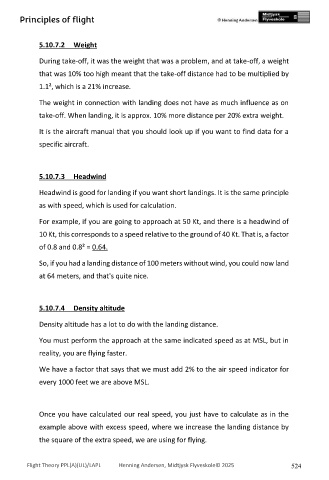Page 524 - PPL-engelsk 2025
P. 524
Principles of flight
5.10.7.2 Weight
During take-off, it was the weight that was a problem, and at take-off, a weight
that was 10% too high meant that the take-off distance had to be multiplied by
1.1², which is a 21% increase.
The weight in connection with landing does not have as much influence as on
take-off. When landing, it is approx. 10% more distance per 20% extra weight.
It is the aircraft manual that you should look up if you want to find data for a
specific aircraft.
5.10.7.3 Headwind
Headwind is good for landing if you want short landings. It is the same principle
as with speed, which is used for calculation.
For example, if you are going to approach at 50 Kt, and there is a headwind of
10 Kt, this corresponds to a speed relative to the ground of 40 Kt. That is, a factor
of 0.8 and 0.8² = 0.64.
So, if you had a landing distance of 100 meters without wind, you could now land
at 64 meters, and that's quite nice.
5.10.7.4 Density altitude
Density altitude has a lot to do with the landing distance.
You must perform the approach at the same indicated speed as at MSL, but in
reality, you are flying faster.
We have a factor that says that we must add 2% to the air speed indicator for
every 1000 feet we are above MSL.
Once you have calculated our real speed, you just have to calculate as in the
example above with excess speed, where we increase the landing distance by
the square of the extra speed, we are using for flying.
Flight Theory PPL(A)(UL)/LAPL Henning Andersen, Midtjysk Flyveskole© 2025 524

